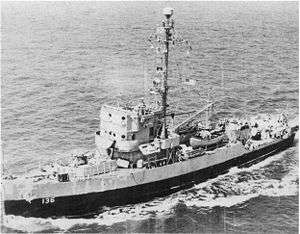Kara Sea U-boat campaign
The Kara Sea U-boat campaign was a submarine operation in the Arctic waters of the Kara Sea during World War II. Originally intended as Operation Wonderland-II (Unternehmen Wunderland II) after Unternehmen Wunderland was protracted after the official end of the operations until 1944.
Background
Unternehmen Wunderland (Operation Wonderland) was a coordinated raid of the pocket battleship Admiral Scheer and U-boats in the Kara Sea occurred in 1942, resulting in a limited German success. A follow-up similar operation code-named Unternehmen Wunderland II was planned for 1 August 1943 with involvement of the Lützow but her participation was cancelled. Despite the official end of Wunderland II for 4 October 1943, operations in Kara Sea resumed the following year until 4 October 1944.[1]
Unternehmen Wunderland II
Since August 1943 U-255 operated near Novaya Zemlya as a refuelling station for a BV 138. The BV 138 searched for Kara Sea convoys to be attacked by Lützow and the Wiking Gruppe.[2]
- On 25 July 1943, Soviet minesweeper T-904 sunk on a mine laid by U-625.[3]
- On 27 July 1943, U-255 shelled and sunk the Soviet survey ship Akademik Shokalskij (ru).[2]
- On 30 July 1043, U-703 sunk the Soviet minesweeper T-911.[3]
- On 5 August 1943, the Soviet motorboat Majakovski (80 tons) sunk on a mine laid by U-212.
- On 25 August 1943, the Soviet salvage ship ASO-1 Shkval sunk on a mine laid by U-625.[3]
- On 27 August 1943, U-354 damaged the Soviet merchant Petrovskij (3771 GRT).[2]
- On 28 August 1943, U-302 sunk the Soviet merchant Dikson (2920 GRT). On the same day, the Soviet submarine S-101 intercepted and sunk U-639 (the only German loss of the 1943 campaign).[2]
- On 6 September 1943, the Soviet merchant Tbilisi (7169 GRT) with a cargo of coal, sunk on a mine laid by U-636.[2]
- On 30 September 1943, U-960 sunk the Soviet merchant Arkhangel´sk (2480 GRT) with a cargo of machinery equipment, part of the Soviet convoy VA-18.[2]
- On 1 October 1943, U-960 attacked convoy VA-18 again, sinking the minesweeper T-896. U-703 attacked the same convoy, sinking the merchant Sergej Kirov (4146 GRT) with a cargo of machinery equipment.[2]
1944

- On 12 August 1944, U-365 attacked the Soviet convoy BD-5: she sunk in succession the minesweepers T-118, T-114 and finally the merchant Marina Raskova (7540 GRT). Of 632 men from the ships, only 186 were saved by minesweeper T-116 and 73 by MBR-2 flying boats.[4]
- On 26 August 1944, U-957 sunk with gunfire the Soviet survey vessel Nord. The ship could fire a single shell in defence (missed) before being sunk.[4]
- On 5 September 1944, Soviet minesweeper T-116 sunk with depth charges U-362.[4]
- On 23 September 1944, U-957 attacked the Soviet convoy VD-1 sinking the corvette Brilliant.[4]
- On 24 September 1944, U-739 too attacked convoy VD-1, sinking minesweeper T-120.[4]
Aftermath
The German operations in the Kara Sea had no effect on Soviet industrial production and the Soviet shipping was only disrupted for a short time. The German operations managed to divert Soviet forces from the operations close Norway.[1]
Footnotes
- Zabecki 1999, p. 1,740.
- Rohwer & Hümmelchen 1992, p. 225.
- Rohwer & Hümmelchen 1992, p. 224.
- Rohwer & Hümmelchen 1992, p. 296.
References
- Rohwer, Jürgen; Hümmelchen, Gerhard (1992) [1972]. Chronology of the War at Sea, 1939–1945: The Naval History of World War Two (2nd rev. ed.). Annapolis, MD: Naval Institute Press. ISBN 978-1-55750-105-9.
- Zabecki, David T. (1999). World War II in Europe: An Encyclopedia (2nd ed.). New York: Garland. ISBN 978-0-8240-7029-8.
_(6983644206).jpg)